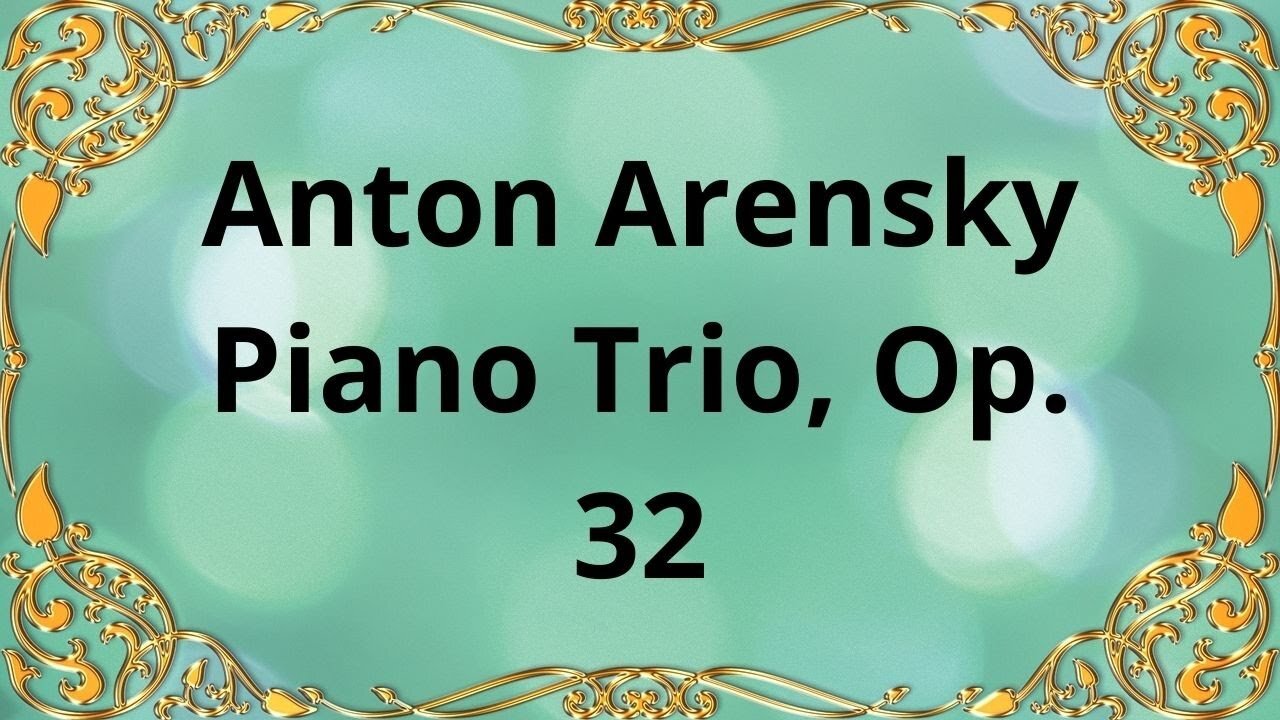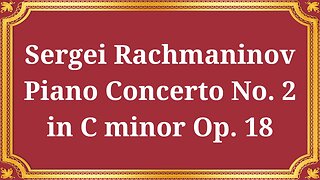Premium Only Content

Anton Arensky Piano Trio, Op. 32
The Anton Arensky Piano Trio, Op. 32, stands as a remarkable composition in the world of classical music. Crafted by the illustrious Russian composer Anton Arensky, this piece has captivated audiences with its captivating melodies, intricate harmonies, and emotional depth. In this essay, we delve into the essence of the Anton Arensky Piano Trio, Op. 32, exploring its historical background, musical structure, and the emotions it evokes, highlighting why it remains an enduring masterpiece in the realm of classical music.
The Anton Arensky Piano Trio, Op. 32, was composed in 1894 as a tribute to the renowned Russian cellist Karl Davidoff, who had a profound influence on Arensky's musical development. This composition reflects the Romantic era's rich musical traditions, with Arensky's unique flair and personal style shining through. The piece consists of four movements, each showcasing the composer's skillful fusion of lyrical melodies and expressive harmonies.
The Anton Arensky Piano Trio, Op. 32, follows the traditional structure of a piano trio, comprising piano, violin, and cello. The first movement, marked Allegro moderato, introduces the main themes with a sense of melancholy and nostalgia, setting the tone for the entire piece. The second movement, a Scherzo, presents a lively and playful character, creating a vibrant contrast to the preceding movement. The third movement, Elegia, conveys deep introspection and sorrow through its soul-stirring melodies. Finally, the Finale brings a burst of energy and excitement, showcasing virtuosic passages and concluding the piece on a triumphant note.
The Anton Arensky Piano Trio, Op. 32, takes listeners on an emotional journey through its intricate composition. The opening movement tugs at the heartstrings, evoking a sense of longing and yearning. As the Scherzo ensues, the mood shifts, injecting a dose of light-heartedness and joy. The Elegia, perhaps the most emotionally charged movement, offers a hauntingly beautiful and melancholic experience, invoking a myriad of emotions within the listener. The final movement acts as a climactic resolution, providing a cathartic release of energy and leaving the audience feeling uplifted and satisfied.
Despite being overshadowed by the works of his contemporaries such as Tchaikovsky and Rachmaninoff, Anton Arensky's Piano Trio, Op. 32, has retained its significance and popularity among classical music enthusiasts. The composition's enduring appeal lies in its ability to resonate with audiences, bridging the gap between profound emotions and musical expression. Its inclusion of virtuosic passages, memorable melodies, and harmonic complexity elevates it to the ranks of other revered piano trios, ensuring its continued presence in concert halls and recordings.
In conclusion, the Anton Arensky Piano Trio, Op. 32, stands as a testament to the talent and artistry of the composer. Its melodic beauty, expressive harmonies, and emotional depth continue to captivate audiences to this day. By exploring the historical background, musical structure, and emotional journey embedded within this masterpiece, we gain a deeper appreciation for its enduring legacy. The Anton Arensky Piano Trio, Op. 32, remains a jewel in the world of classical music, showcasing the timeless power of music to move and inspire us all.
1. Scherzo (Allegro Molto) 00:00
2. Elegia (Adagio) 06:46
3. Finale (Allegro Non Troppo) 13:16
#classical_music #Anton_Arensky #Piano_Trio
-
 34:38
34:38
Classical music_Music Inspiration
19 days agoSergei Rachmaninov Piano Concerto No. 2 in C minor Op. 18
41 -
 LIVE
LIVE
The Quartering
43 minutes agoTrumps SAVE Act Passes, China Amazon Sellers PANIC, Russell Brand's Bad Take, & More
21,050 watching -
 LIVE
LIVE
Russell Brand
1 hour agoThe Trans Con: How Did We Miss THIS?! – SF564
7,034 watching -
 1:02:31
1:02:31
Timcast
2 hours agoTrump Raises TARIFF On China To 145% , China PANICS As Trump Isolates Nation, Market STILL In Chaos
148K91 -
 DVR
DVR
Sean Unpaved
1 hour agoGreen Jackets & Hardwood: Masters Tournament Tee-Off, Jokic on Malone, Luka's Big Night In Dallas
9.14K2 -

The Charlie Kirk Show
2 hours agoBetter Know Your Bonds + Decoupling China | Cardone, Ganz, Sedra | 4.10.25
56.3K12 -
 2:13:54
2:13:54
Steven Crowder
4 hours ago🔴 How Trump's Massive Tariff Announcement Destroyed China & the Left
369K187 -
 LIVE
LIVE
Ben Shapiro
1 hour agoEp. 2177 - TRUMP U-TURN WIN: Tariff War Paused, China Isolated!
2,055 watching -
 LIVE
LIVE
Canada Strong and Free Network
5 hours agoCanada Strong and Free Network
431 watching -
 44:14
44:14
The Rubin Report
3 hours agoLiberals Saddened as AOC’s Hypocrisy to ‘Fight Oligarchy’ Is Exposed
98.1K39